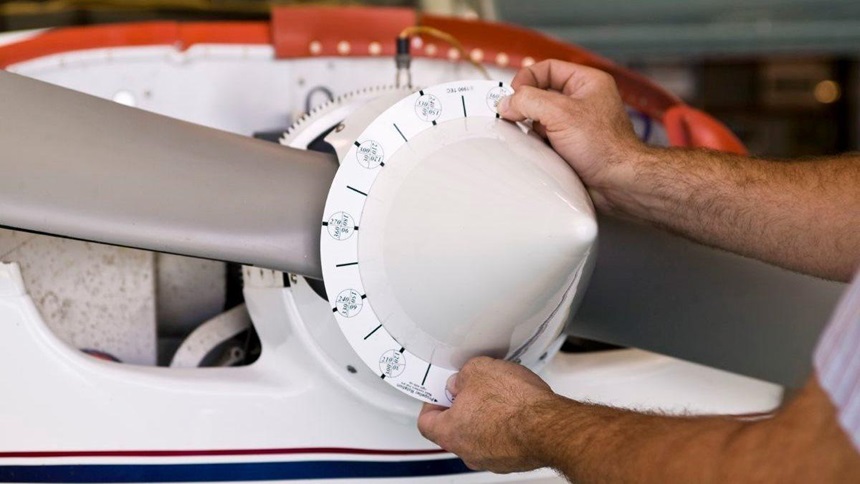Prop Mechanics
Safety Spotlight: Aircraft Systems

Basic propeller designs have changed little in the past 30 years or so, although incremental advances in blade aerodynamics have improved efficiency slightly. Modern production techniques have also helped reduce overall weight. Nonetheless, pilots ought to be familiar with a few basic types of props. At best, a prop is about 85 percent efficient at converting torque to thrust.
Fixed-Pitch
Used when low weight, simplicity, and low cost are needed, the fixed-pitch prop is a compromise. Because in most cases the pitch setting is ideal for neither cruise nor climb, the airplane suffers a bit in each performance category. Fixed-pitch props simplify power management and cost less to overhaul than a constant-speed version.
Constant-Speed
Before there were constant-speed props, there were adjustable-pitch models. By altering each blade’s angle of attack, the prop can be better optimized for both climb and cruise performance. Early models used manual adjustment of the prop pitch, while a few pioneer investors played with automatic pitch-change mechanisms.
At best, a prop is about 85 percent efficient at converting torque to thrust.
A separate mechanism is used to alter each blade’s angle of attack, with the goal to maintain a constant engine speed. In a fixed-pitch prop, as the airplane accelerates, the engine—given a fixed throttle position—will follow suit. With a constant-speed arrangement, the blades’ angle of attack increases as the engine tries to accelerate, loading the engine and maintaining the set speed.
This setup provides two main benefits over fixed-pitch propellers. First, you get a more optimum blade pitch setting, and second, the engine can be made to run at a set speed, greatly reducing pilot workload and making precise power settings possible.
Governing
Integral to the constant-speed setup is a device called the governor. It is geared to the engine and takes oil from the main engine supply. An internal pump increases the pressure of this oil and directs it, through the hollow nose of the crankshaft, to the propeller. In single-engine applications, oil pressure serves to increase the pitch of the blades (called coarse pitch), which in turn reduces engine rpm. Twins and some aerobatic aircraft operate so that engine oil forces the blades to fine pitch. Pilots should follow manufacturers’ recommendations for feathering props and securing engines after failures.
Feathering
 A feathering propeller is simply a constant-speed unit that can rotate the blades until they are nearly aligned with the relative wind. This provides reduced drag in the event of an engine failure. Feathering props are found on most twin-engine airplanes.
A feathering propeller is simply a constant-speed unit that can rotate the blades until they are nearly aligned with the relative wind. This provides reduced drag in the event of an engine failure. Feathering props are found on most twin-engine airplanes.
Blade Materials
Today, the vast majority of props in general aviation are metal—specifically aluminum. In the days before sophisticated metallurgy and precision metalworking tools, the wooden propeller reigned supreme, and it’s still popular for ultralights, small experimental aircraft, and antique models. There are also a few composite (fiberglass, Kevlar, and graphite) props in circulation; most of these use either a foam or wood core wrapped with fiberglass cloth. Potentially, the composite prop can be lighter than a metal prop, and its stiffness-to-weight ratio is better, but so far the certificated composite propeller has proven to be too expensive for most GA aircraft.
Hubs
The function of the hub is to fasten the propeller blades to the engine. For most fixed-pitch props, the hub is integral to the blades. Constant-speed props need to allow the blades to rotate in the hub. Many different blade retention systems have been used throughout the years, with the more recent designs intended to be long-wearing and corrosion resistant.
As the fleet ages, it’s becoming more common to hear of prop-hub distress in addition to the more prevalent blade maladies. Failures of hubs are comparatively rare. Typically, the hub problems involve cracking prior to failure. Corrosion pits inside the hub can cause cracks to form when the hub is subjected to operating stresses. Such incidents are particularly distressing because they are preventable with proper maintenance and overhaul. Prior to failure, a cracked hub or blade retention component may provide a warning with the sudden onset of grease or oil leakage or vibration.